
Rough Terrain Forklifts Training Prince Albert - There are in reality two categories of forklifts within the production industry, the rough terrain model and the industrial version. Rough terrain forklifts appeared in the 1940's intended primarily for use on rough roads, perfect for lumberyards and construction sites, providing hauling power when there was no paved surface existing.
Rough terrain lift trucks generally employ an internal combustion engine with a battery for power. The engines can function on propane, diesel or gas. Many makers are playing with rough terrain lift trucks that consume vegetable matter and run from ethanol. Large pneumatic tires with deep treads characterize these lift trucks to allow them to clutch onto the roughest soil type devoid of any slippage or drifting.
Some of the original versions of rough terrain forklifts had the capability to raise in excess of 1000 lbs, by means of forks that could run underneath the item, jack it slightly and move it to a different site. After more than ten years on the market, rough terrain lift trucks were reinforced with added hauling power, increasing the potential load to more than 2000 lbs. Telescoping booms were added in the 1960's, enabling them to stack materials a great deal higher than in previous years. The telescoping design characteristic is a staple of nearly all all terrain lift trucks today. Present styles are capable of handling well over 4000 lbs thanks to the continued improvements through the years. Telescoping capability has also improved with some versions attaining a height of 35 feet. Operator safety has also become a focus with several all terrain forklifts currently manufactured are equipped with an enclosed cab for the operator, versus the older open air seating capacity.
The all terrain forklifts on the market these days both function well on unpaved surfaces and paved floors. This type of all terrain forklift is marketed for its' adaptability permitting the possibility for establishments to use one unit to transfer materials from an outside working site into a warehouse.
-
Komatsu Forklift
Komatsu Forklift Training Prince Albert - Komatsu Forklift U.S.A. Inc. has a very good reputation for building reliable and resilient lift trucks. Komatsu is renowned around the world as a business with a rich heritage while retaining an outstanding... More -
Pneumatic Forklifts
Pneumatic Forklifts Training Prince Albert - Pneumatic lift trucks are known as pallet vehicles or pump trucks and are broadly used in warehouses and shipping plants to transport materials on pallets. Pneumatic forklifts comprises a set of metal fork... More -
Genie Forklift
Genie Forklift Training Prince Albert - Genie is a universally predictable corporation that enjoys the spirit of alliance with their extensive network of connected customers. Genie Industries prides itself on the idea of bringing materials and people... More -
Boom Lifts
Boom Lifts Training Prince Albert - Boom lifts are machinery that has a platform that can be lowered or lifted to various heights, thus making this piece of equipment an important requirement in a wide range of professions. Accessible in many differe... More -
Doosan Forklift
Doosan Forklift Training Prince Albert - Doosan Infracore Company Ltd. is an international and intercontinental corporation that consists of Defense Industry Products, Industrial Vehicles, Diesel Engines, Automation Systems, Machine Tools and Constr... More

Forklift Certification Prince Albert
TOLL FREE: 1-888-254-6157
Prince Albert, Saskatchewan
forkliftcertificationprincealbert.com
Email Us
About Us


